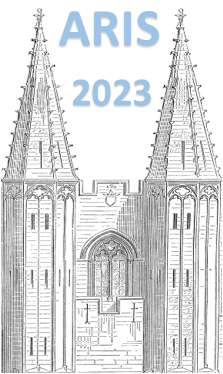Orateur
Description
A novel approach to produce medically important radionuclides using inverse kinematics [1-3] has been developed at the Cyclotron Institute at Texas A&M University. The methodology involves a heavy-ion beam of appropriate energy impinging on a light gas target (e.g., $H_{2}$, $D_{2}$, $^{3-4}$He, …) and collecting the isotope of interest, focused along the beam direction, on a foil catcher after the target. In addition, secondary emitted particles such as neutrons from the primary nuclear reaction can be used to irradiate a secondary target for further radionuclide production. As the quantity of the material required to prepare the heavy-ion beam is considerably smaller than that used in the standard solid target approach, material costs are expected to be reduced via this methodology. The theranostic radionuclide $^{67}Cu$ ($T_{1/2} = 62 h$) was produced through the reaction of a $^{70}Zn$ beam at 15 MeV/nucleon with a hydrogen gas target [1-2]. The $^{67}Cu$ radionuclide alongside other coproduced isotopes, was collected after the gas target on an aluminum catcher foil. Their radioactivity was measured by off-line $\gamma$ -ray analysis. In addition, the forward-focused neutrons from the primary reaction were used to irradiate a $^{nat}Zn$ target in order to produce more $^{67}Cu$. Pursuing this initial investigation, the well-known $^{99}Mo/^{99m}Tc$ generator system [3] was also investigated with a beam of $^{100}Mo$ at 12MeV/nucleon on $^{4}$He gas cell target for three different gas pressures. The methodology was tested with success. The production of the $^{67}Cu$ and $^{99}Mo$ were predominant in comparison with the various radio-impurities. In order to achieve production appropriate for preclinical studies, high-intensity heavy-ion primary beams are necessary.
References
[1] Souliotis, G. et al. A novel approach to medical radioisotope production using inverse kinematics: A successful production test of the theranostic radionuclide $^{67}Cu$. Applied Radiation Isotopes 149, 89–95, DOI: https://doi.org/10.1016/j.apradiso. 2019.04.019 (2019).
[2] Rodrigues, M.R.D. et al. A novel approach to medical radioisotope production using inverse kinematics, EPJ Web of Conferences 252, 08002, DOI: https://doi.org/10.1051/epjconf/202125208002 (2021).
[3] Mabiala J. et al. Enhanced production of $^{99}$Mo in inverse kinematics heavy ion reactions, EPJ Web of Conferences 252, 08003. DOI: https://doi.org/10.1051/epjconf/202125208003 (2021).
[4] Rodrigues M.R.D. et al., Radiation Physics and Chemistry submitted.

